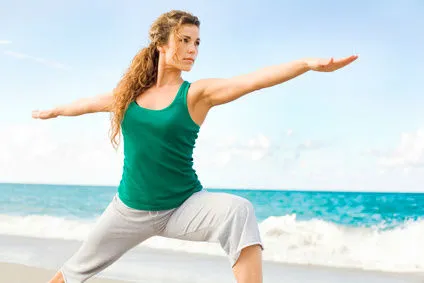
- Share on Facebook71
- Share on Pinterest
- Share on Twitter
The ancient practice of yoga has been linked to numerous health benefits. Just a few include lowered stress levels, better flexibility and balance, improved focus and memory, stronger bones, greater lung capacity, relief from chronic pain and lowered blood pressure. Some claim that hot yoga offers even more benefits, but is that really the case?
The most well-known type of hot yoga is Bikram yoga, in which 26 yogic poses are performed over a 90 minute session, in a room up to 105 degrees Fahrenheit. There are certain benefits to this type of yoga. According to yoga instructor Taj Harris, “the heat allows the body to be more supple. It increases joint lubrication as well as flexibility in muscles.”
She adds, “people like to sweat, they enjoy the way their body feels after a nice heated stretch. I have the pleasure of watching some students work through tightness, strains and pains with a regular hot yoga practice.”
Additionally, hot yoga, such as Bikram yoga, can help improve the quality of your skin, as sweating removes impurities through your pores. It is also very satisfying for some people, as the blood vessels dilate, and can allow for enhanced relaxation into the poses.
Some people claim that sweating during yoga can lead to an even deeper detox, as the blood flow through your body is relaxed and more toxins are released through your sweat. While sweating can contribute to detoxing, it is primarily the role of the liver and kidneys.
It has not yet been established if sweating significantly contributes to the body’s ability to push out deeper-seated toxins, although one thing is for sure, this practice must be coupled with a nutritious diet if you want to see any detox benefits.
One myth surrounding hot yoga is that it can boost the metabolism. According to many health and fitness experts, this is not accurate, as the body remains at a constant core temperature despite the temperature of the room – hence the sweating.
While the movements involved in yoga indeed can burn calories, the heat likely contributes little to this. According to Dr. Cedric Bryant, chief science officer of the American Council on Exercise (ACE), “people think the degree of sweat is the quality of the workout, but that’s not reality. It doesn’t correlate to burning more calories.”
Bryant adds, “as far as physical benefits, you can get those from a standard yoga class.” He also warns that the extreme temperatures of hot yoga classes may be too much for some individuals to handle. “Dizziness, headache, lightheadedness, mild nausea and muscle cramps are indicators that you’re not tolerating the heat. You need to remove yourself from that environment.”
Experts have, however, stated that when done safely and with awareness of your body’s signals, hot yoga does not pose a health risk.
While there are advantages to your skin and hot yoga can relieve muscle soreness, the decision as to whether to sign up for Bikram yoga or a ‘cold’ yoga practice, such as traditional Hatha yoga, is largely personal. Yoga itself offers innumerable advantages to body, mind and emotional states, which only increase over time.
 If you are more easily able to center yourself in a state of mindfulness, and better able to relax, in a hot yoga environment, go for it! However, if you find the heat uncomfortable and burdensome, you’re likely not missing much by doing your yoga at a cooler temperature. While Bikram yoga has proved highly beneficial for many people, it’s hard to say whether the benefits came from the heat, or simply the practice of yoga.
If you are more easily able to center yourself in a state of mindfulness, and better able to relax, in a hot yoga environment, go for it! However, if you find the heat uncomfortable and burdensome, you’re likely not missing much by doing your yoga at a cooler temperature. While Bikram yoga has proved highly beneficial for many people, it’s hard to say whether the benefits came from the heat, or simply the practice of yoga.
If you do choose to go the steamy route, Harris recommends drinking plenty of water during your session, wiping away excess sweat as you go, and moving to the floor if you need to settle in a slightly cooler spot for a while.
-The Atlernative Daily
Sources:
http://www.huffingtonpost.com/2013/10/28/body-on-yoga_n_4109595.html
http://health.howstuffworks.com/wellness/diet-fitness/yoga/bikram-yoga-explained.htm
http://bikramyogamemphis.com/2011/05/13-extraordinary-benefits-of-bikram-yoga
- Share on Facebook71
- Share on Pinterest
- Share on Twitter

